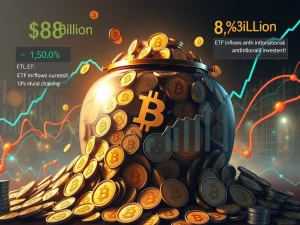Urgent Bitcoin Fee Crisis: Can BTCfi Revolutionize Network Security?

The Bitcoin network, long hailed as digital gold, faces an urgent challenge. A significant drop in Bitcoin transaction fees threatens its long-term security model. This alarming trend has sparked widespread concern among miners and enthusiasts alike. Can BTCfi, Bitcoin-native Decentralized Finance, emerge as the revolutionary solution to this pressing Bitcoin fee crisis?
The Alarming Decline in Bitcoin Transaction Fees
Recent data reveals a troubling trend for the Bitcoin network. Daily transaction fees have plummeted by over 80% since April 2024. This drastic reduction raises serious questions about the sustainability of Bitcoin’s economic model. For instance, a report from Galaxy Digital highlights this collapse, painting a stark picture for the network’s future. By August 2025, nearly 15% of all blocks are considered “free.” This means miners process them with minimal or no transaction fees, often just one satoshi per virtual byte or less. While cheap transactions benefit users, they pose a severe problem for miners and, consequently, for the network’s foundational security.
Bitcoin’s incentive structure relies on a dual compensation model for miners: block rewards and transaction fees. However, the April 2024 halving drastically cut block rewards to 3.125 BTC per block. This reduction forces miners to depend more heavily on the fee market. Unfortunately, this vital market is currently drying up. Pierre Samaties, chief business officer at the Dfinity Foundation, aptly explains the dilemma. “As block rewards shrink, more weight falls on transaction fees,” he told Crypto News Insights. “If usage does not grow, that base thins, and the guarantees weaken. Sustained throughput is essential for the system to defend itself.” This statement underscores the critical link between on-chain activity and the network’s ability to protect itself from attacks.
The average Bitcoin transaction fees show a clear downward trajectory. This trend directly impacts miner profitability. Lower profitability can lead to fewer miners securing the network, potentially reducing its overall robustness. Therefore, finding new ways to generate on-chain activity and boost fees is not merely an economic concern; it is a fundamental issue for Bitcoin network security.
Understanding the Roots of the Bitcoin Fee Crisis
Several factors contribute to the current Bitcoin fee crisis. One primary reason is the significant slowdown in Bitcoin’s on-chain activity. Non-monetary trends, such as Ordinals and Runes, once drove considerable transaction volume. These trends have since declined. Galaxy’s report notes a dramatic shift: OP_RETURN transactions, heavily used during the 2024 Ordinals boom, now account for just 20% of daily volume. This marks a sharp decrease from their peak of over 60%.
Moreover, alternative Layer 1 blockchains are attracting users for specific use cases. Platforms like Solana are gaining traction for high-frequency activities, including memecoins and NFTs. These networks often offer faster transaction speeds and lower costs, diverting potential activity away from Bitcoin’s base layer. Consequently, this reduces the demand for block space on Bitcoin. Furthermore, the rise of spot Bitcoin ETFs has inadvertently impacted the fee market. These ETFs now hold over 1.3 million BTC. They facilitate off-chain trading and custody, limiting the on-chain movement that would typically generate transaction fees. This shift means more Bitcoin volume occurs without directly interacting with the network’s fee mechanism.
The Bitcoin fee market operates on an elastic design. Fees rise when demand for block space surges and fall when activity slows. However, if this demand continues to shrink, miners may lack sufficient incentive to secure the network. Galaxy Digital observed that nearly 50% of recent blocks have not been full. Mempool activity also remains sluggish. These indicators point to a persistent lack of demand for block space, exacerbating the fee problem. Therefore, a solution must stimulate genuine, sustained on-chain activity to ensure the network’s long-term health.
BTCfi: A Beacon of Hope for Network Security
Against this backdrop of declining fees and reduced on-chain activity, a promising solution emerges: BTCfi. This term refers to Bitcoin-native Decentralized Finance. Unlike DeFi applications built on Ethereum (ETH) or Solana (SOL), which utilize smart contracts on those respective chains, BTCfi builds financial applications directly on or interacting with the Bitcoin network. It leverages Bitcoin as the base asset. These applications include lending, trading, and yield generation. They operate on layers or protocols designed to interface seamlessly with Bitcoin’s robust blockchain.
The core principle of BTCfi offers a direct remedy for the fee crisis. “Every BTCfi action requires moving Bitcoin,” Pierre Samaties explains. “Movement drives computation, computation consumes block space, and space carries cost.” In essence, increased adoption and utilization of BTCfi applications directly translate into more on-chain transactions. This, in turn, boosts demand for block space and generates higher transaction fees for miners. Thus, BTCfi provides a mechanism to revitalize the fee market, strengthening Bitcoin network security.
The growth of BTCfi could fundamentally alter Bitcoin’s economic landscape. By creating new use cases and financial opportunities directly on Bitcoin, it encourages users to interact with the base layer more frequently. This increased interaction is crucial for maintaining a healthy fee market. Consequently, a vibrant BTCfi ecosystem could ensure that miners receive adequate compensation, even as block rewards continue to decrease in future halvings. This shift moves Bitcoin beyond a mere store of value, transforming it into a dynamic financial primitive.
From Digital Gold to Financial Primitive: The Evolution of Bitcoin DeFi
For years, Bitcoin has primarily served as “digital gold,” functioning as a store of value rather than a highly usable asset. However, the emergence of Bitcoin DeFi (BTCfi) signals a profound evolution. Pierre Samaties envisions Bitcoin transforming into a “financial primitive.” He defines a financial primitive as “a building block developers can use to design flows, tools, and logic.” In this expanded role, Bitcoin becomes more than just an asset to hold. It becomes a programmable component within broader financial systems. This conceptual shift is vital for its long-term viability and security.
Julian Mezger, chief marketing officer of Liquidium, reinforces this perspective. He highlights significant infrastructure improvements as setting the stage for this change. “The last five years have transformed Bitcoin’s infrastructure from a simple settlement layer into a multi-layered ecosystem,” Mezger stated. “We’re now seeing the foundations for true Bitcoin-native DeFi being laid.” These foundational developments include advancements in Layer 2 solutions, sidechains, and various protocols that enable complex financial operations without compromising Bitcoin’s core security principles. Such innovation is critical for expanding Bitcoin’s utility and driving on-chain demand for transaction fees.
The transition to a financial primitive means Bitcoin can support a wider array of applications, including:
- Lending and Borrowing: Users can collateralize their BTC for loans or lend out BTC to earn yield.
- Decentralized Exchanges (DEXs): Trading various assets directly on Bitcoin or its layers.
- Stablecoins: Issuing stablecoins pegged to fiat currencies or other assets, secured by BTC.
- Yield Generation: Strategies to earn passive income from Bitcoin holdings.
Each of these applications inherently requires on-chain interactions, generating the much-needed transaction fees that support network security. This expanded utility promises to unlock new economic potential for Bitcoin, ensuring its relevance and robustness for decades to come.
Driving On-Chain Activity: How BTCfi Boosts Transaction Fees
The primary mechanism through which BTCfi addresses the Bitcoin fee crisis is by stimulating genuine on-chain activity. Every operation within a BTCfi application, whether it is depositing collateral for a loan, swapping assets on a decentralized exchange, or participating in a yield farming protocol, necessitates interaction with the Bitcoin blockchain or its closely integrated layers. These interactions consume block space. Consequently, they generate fees for miners. This contrasts sharply with off-chain activities, such as trading Bitcoin on centralized exchanges or holding it in an ETF, which do not directly contribute to the network’s fee market.
Consider the practical implications:
- Lending Protocols: When users lock BTC as collateral, this action typically involves an on-chain transaction. Repaying loans or withdrawing collateral also creates transactions.
- Decentralized Trading: Swapping BTC for other assets on a Bitcoin-native DEX requires recording these exchanges on the blockchain, generating fees.
- Synthetic Assets and Wrapped BTC: Creating synthetic assets or wrapping BTC for use on other chains often involves initial on-chain locking and unlocking processes.
These diverse activities collectively increase the demand for block space. This heightened demand, in turn, drives up transaction fees. The fee market, being elastic, responds directly to this increased utility and usage. Therefore, a thriving BTCfi ecosystem offers a sustainable path to bolster miner revenue. It ensures that miners remain incentivized to dedicate computational power to secure the network. This continuous incentive is paramount for maintaining robust Bitcoin network security against potential attacks.
Furthermore, the innovation within the Bitcoin DeFi space continues to accelerate. Developers are building more sophisticated applications and infrastructure layers. These developments make BTCfi more accessible and attractive to a broader user base. As more users engage with these applications, the volume of on-chain transactions will naturally increase. This organic growth in usage is essential for creating a healthy and competitive fee market, which is critical for Bitcoin’s long-term health. The future of Bitcoin’s economic model hinges significantly on the success and widespread adoption of BTCfi solutions.
The Path Forward: Securing Bitcoin’s Future with BTCfi
The current Bitcoin fee crisis presents a significant challenge. However, it also highlights an unprecedented opportunity for innovation. BTCfi offers a compelling vision for Bitcoin’s future. It transforms the network from a passive store of value into an active, programmable financial ecosystem. This evolution is not just about creating new financial products; it is fundamentally about reinforcing Bitcoin network security by ensuring miners receive adequate compensation for their vital work.
The journey towards widespread BTCfi adoption will involve overcoming several hurdles. These include scalability challenges, user experience improvements, and regulatory clarity. However, the foundational infrastructure is rapidly maturing. Developers are actively building robust solutions on layers like Liquid Network, Stacks, and Rootstock. These platforms enable smart contract functionality and more complex financial operations while leveraging Bitcoin’s inherent security. As these layers become more efficient and user-friendly, the barrier to entry for BTCfi will decrease, attracting more participants and driving greater on-chain activity.
The stakes are high. Without a sustainable fee market, Bitcoin’s long-term security model faces increasing pressure. However, with the promise of BTCfi, there is a clear path forward. By embracing Bitcoin-native DeFi, the community can unlock new utility for BTC, generate essential transaction fees, and ensure the network remains the most secure and robust blockchain in the world. This proactive approach is vital for Bitcoin to continue its role as a cornerstone of the global financial system, evolving beyond digital gold into a truly programmable financial primitive for the digital age.








